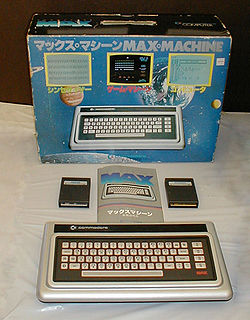 | |
| Also known as | Ultimax, VC-10 |
|---|---|
| Type | Console / home computer |
| Release date | 1982 |
| Introductory price | US$200(equivalent to $650 in 2024) |
| Discontinued | 1982 |
| Operating system | none - optional MAX BASIC (Cartridge) |
| CPU | 6510 @ 1.02 MHz |
| Memory | 2 KB, 0.5 KB color RAM |
| Graphics | VIC-II 6566 (320 x 200, 16 colors, sprites, raster interrupt) |
| Sound | SID 6581 (3x Osc, 4x Wave, Filter, ADSR, Ring) |
| Predecessor | VIC-20 |
| Successor | Commodore 64 |

MAX Machine (or simply MAX), also known as Ultimax in the United States and Canada and VC-10 in Germany, [1] is a home computer designed and sold by Commodore International in Japan, beginning in November of 1982, [2] a cousin to the popular Commodore 64, also sharing a lot of components with the C64. [3] [4] The Commodore 64 manual mentions the machine by name, suggesting that Commodore intended to sell the machine internationally; however, it is unclear whether the machine was ever actually sold outside Japan. When it was officially presented, in Tokyo, for the first time, it was named Commodore VICKIE. [5]
Contents
The unit has a membrane keyboard and 2 KB of RAM internally and 0.5 KB of color RAM (1024 × 4 bits). It uses a television set for a display. It uses the same chipset and 6510 CPU as the Commodore 64, the same SID sound chip, and a MOS Technology 6566 graphics chip, a version of the VIC-II that powers the C-64 graphics for the MAX' static RAM. A tape drive could be connected for storage, but each cartridge had to implement its own cassette driver and protocol routines, so the tape could only be used by 2 of 24 released programs. The MAX also lacks the serial and user ports necessary to connect a disk drive, printer, or modem. [6] The lack of any built-in operating system, not even a simple bootstrap OS, combined with the fact that all the software released for the platform are video games (besides a scaled down cartridge-based BASIC with no disk, modem, or printer support) positions the Max as a video game console rather than a home computer, despite sharing much of the Commodore 64's chipset. The MAX's 2KB of RAM also indicates it was intended as a games machine and not a personal computer. Even the Commodore PET, released five years earlier in 1977, had a minimum of 4K RAM, and rapidly 8K became the minimum. Even the VIC-20, heavily criticized for its minimal RAM, shipped with 5K of RAM.
Software is loaded from plug-in cartridges - turning on the MAX with no cartridge inserted yielded only a blank screen. Its ROM cartridge architecture was compatible with that of the C-64, so that MAX cartridges will work in the C-64. [7] The MAX compatibility mode in C-64 was later frequently used for "freezer" cartridges (such as the Action Replay), as a convenient way to take control of the currently running program. [8] [6]
It was intended to sell for around US$200. Although the MAX had better graphics and sound capability, Commodore's own VIC-20, which sold for around the same amount, was much more expandable, had a much larger software library, and had a better keyboard—all of which made it more attractive to consumers. The MAX never sold well and was quickly discontinued.
